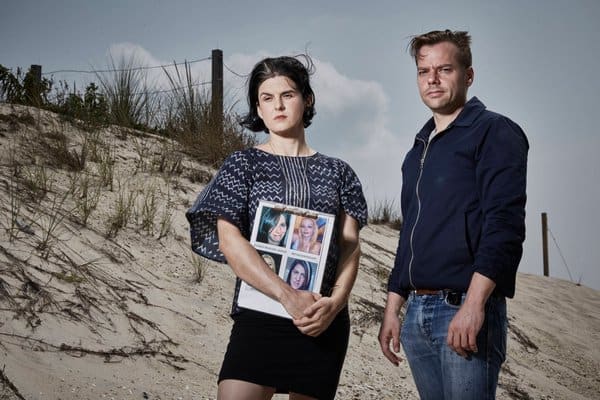
The Long Island serial killer case brought fear to the public, and the crime spree has never been solved. Enter A&E’s new documentary series The Killing Season, which revolves around the infamous events. Each of the eight episodes takes a closer look at the case as reporters Rachel Mills and Josh Zeman tackle clues, look at the case’s leads, and also explore other serial murder files. Fans of real life crime series and those with an interest in the Long Island killer and victims are eagerly anticipating its premiere on November 12, 2016. Here are ten things you can expect to see on The Killing Season.
1. A humanizing view of the victims.
As most of the victims of the Long Island serial killer were sex workers, some of the public and media unfortunately didn’t care much about their fates. One important part of The Killing Season is that it will reveal a bit more about their lives outside of the stigma and who they were before being struck down.
2. An in-depth look at the Long Island serial killer case and details that most of the public doesn’t know.
When the case first started in Gilgo Beach in 2010, there was a lot of information leaked to the media. However, much has been kept under wraps and in this series many things that people weren’t aware of will be talked about. It’s one of the more interesting parts of the documentary series and will have everyone thinking about the case in a new way.
3. Examination of other serial killer cases that are yet to be solved.
To help them see if they can get a solid clue as to what really happened to the victims and who the killer may be, Mills and Zeman also go to Oklahoma, Albuquerque, Florida, and Atlantic city to look at the details of other serial murder cold cases. This actually comprises a large part of the series, and brings forth the question of whether what happened in the Long Island case is in any way connected to tragic killings elsewhere.
4. Activities that verge on being illegal.
There’s one moment in The Killing Season that Zeman and Mills admit is probably unethical and even illegal. Still, they do it to try and get a better view of what it’s like in the world of prostitution, which is what many of the cold case victims were involved in. No, neither host sells themselves or solicits anyone. However, what does go down is definitely an interesting part of the series that viewers will find intriguing.
5. Some over-hyped moments.
This is a true crime documentary, but The Killing Season is also supposed to be entertaining. If you’re not a fan of haunting synth soundtracks and a bit of dialogue that seems more fake than real, don’t be surprised to see a bit of it in this program. Thankfully those aspects don’t ruin the show and the gimmicks and over-done drama are kept to a minimum. For the most part, those who want to delve deeper into these unsolved crimes will get what they want out of the show, and it’s certainly informative.
6. Heartbreaking scenes.
While the media didn’t do much in the way of showing the public who the victims of the talked about crimes were, The Killing Season does and it can get emotional at times. Not all of the victims of the killers were sex workers, and some included children — hearing about what happened to them can get pretty tough, but it shows just how devious the perpetrators of the crimes were. And even the stories of the victims who were escorts is heart wrenching, especially when you hear how some of them fell into that life in the first place.
7. Criticism of the investigations.
One thing that may be controversial is the premise of the show itself and the questions that some of the episodes of The Killing Season raise. Let’s get it out of the way: had law enforcement agencies been able to crack these cold cases, the two sleuth reporters wouldn’t have a show in the first place. Why did so many of the victims only get a sluggish response to reports of them being missing? What would’ve happened had officials acted quickly and with more fervor? These are tough questions, but they’re important ones that the show throws out to the audience.
8. The revelation of how many flaws are in the system.
Some people already know that there’s a problem when it comes to coordinating effective efforts to find missing persons, but The Killing Season formally introduces its audience to the concept of what the hosts call “linkage blindness”. Basically, it’s what they think has hindered law enforcement from drawing connections between the cases and even solving some of them, and it’s a nationwide problem. If the program is able to bring more awareness to this one issue, it would do a lot of good and the masses can become more active in pushing for officials to address it.
9. Some frustrations along the way for you, the viewing audience.
The way that the series is structured works in some ways, but then again there are some gaps and frustrations. To be clear, none of this makes The Killing Season unworthy of watching — on the contrary, it’s definitely worth tuning into. However, be prepared for the hosts to skip around a bit between cases instead of linking them together in a way that’s easier to follow.
For instance, the bulk of the first part of the series is all about the Long Island killer case, but then several episodes go by without much fresh information being introduced about it. All the while the focus turns over to other cold cases, and that may leave some feeling the like hosts totally forgot about the original topic of the program. Don’t fear, however. By the end of the eight episode run, they come full circle back to the Long Island serial killer case and what it all means in the grand scheme of things.
10. Don’t expect for the killer to be revealed.
At the end of the series, the duo doesn’t figure out who the Long Island serial killer is, or who any of the other perpetrators involved in the other cold cases are. However, that’s not the main objective of The Killing Season. It’s more about looking at other aspects of the cases and getting the history behind them.
 Follow Us
Follow Us





